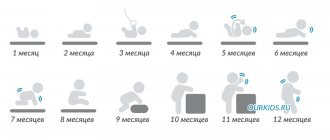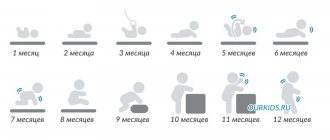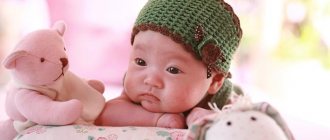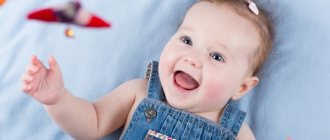Young children develop quickly, especially in the first year of life. Until recently, the baby was like a small lump; he could not hold his head up or focus his eyes, but in a short time he learned to pronounce sounds, crawl and took his first steps. You need to know what a child’s development should be at 1 year old in order to respond in time to possible deviations. In the first 12 months of life, the baby has already learned a lot, but the most important stages of growing up and development await him - going to kindergarten and school, so it is necessary to ensure timely vaccination according to the vaccination calendar and competent care for the baby.
The most important thing is that there is love in the family.
Norms for children one year old
In the first year of life, children grow actively, they add 1-1.5 cm per month, after 12 months this process slows down a little. They actively gain weight - 300-350 g in 30 days, the circumference of the head and chest increases by an average of 5 mm.
By the end of the first year, the baby triples its weight, then the rate of increase decreases.
At this age, the feet are still flat, but after the child begins to walk, the fat folds will gradually disappear and a curve will form.
On average, up to 8 teeth appear, but this is all conditional, some have 10-12, while others have only 2. You need to worry if by the end of the first year there are no teeth at all.
Boys
Boys are often born larger and develop slightly faster during this period. On average, their weight is 8.9-11.6 kg, and their height is 72.3-79.7 cm. These are data from domestic pediatricians; according to the WHO classification, the range is slightly larger.
Girls
They grow a little slower and by the end of the first year they reach 71.4-78 cm, and their weight is 8.5-10.8 kg.
Motor activity of the child
What a one-year-old child can do cannot be compared with his skills just a few months ago. He has already learned much better how to handle his own body, he is very active, moves a lot and in a variety of ways. The baby can calmly hold two objects in his hands, can assemble a pyramid, or even hold a spoon at the table while feeding. Of course, in many activities he still needs the help of his parents: such young children are able to concentrate on something for only a few minutes.
Active movements.
The child crawls, stands on his legs, including from a squatting position, and gets up on his knees independently. He can climb on or off a chair or sofa, and with the help of his parents, he can go up or down the stairs. Children are very inquisitive, so at this age they should not be left near open windows or dangerous objects. The kid can figure out how to get to the windowsill using a chair. Fine motor skills become much better: the child can pick up a small object with two fingers, take a cup and drink from it.
Dancing.
Little children love music. Many people notice that, having heard an interesting melody, the baby begins to dance actively: he likes it. Some not only dance, but also try to sing along to children's songs. If the child does not do this, you can show him a simple dance, and he will begin to repeat without prompting from mom or dad.
Moving quickly on all fours
. Almost all babies at this age are already crawling, and quite quickly. Some skip the stage of walking on all fours and immediately stand on their feet, but this does not happen for everyone. Most often, a one-year-old child moves calmly by crawling.
Walking with parental support.
Some children are already starting to take their first steps. Few people begin to walk independently, but most babies can already walk unsteadily while holding mom or dad’s hand. Some people try to walk while holding onto walls or other support. However, there are also children who are in no hurry to start walking on two legs, and this is completely normal. If your child has not gone yet, there is no need to rush him. Dr. Komarovsky suggests that in such cases, holding off on walking may even be useful: walking upright is a serious load on the back, and perhaps the baby is simply not ready for it yet [1].
Physical development
This is a period of rapid physical development. So that parents can control whether their baby is growing correctly, WHO has developed average indicators of height, weight, etc., separately for girls and boys of this age.
Due to the active growth of teeth, children's gums swell, their temperature rises and they become capricious.
The muscles have become strong enough for the child to crawl independently, then stand and walk.
Height and weight
About 10% of all children correspond to the average height and weight indicators. The rest have deviations, both upward and downward. This is normal, a lot depends on heredity. You need to worry when your baby suddenly stops growing or gaining weight.
Table: average growth rates for one-year-old children according to WHO
| Floor | lower limit | Upper limit |
| Boys' height, cm | 71 | 80,5 |
| Girls' height, cm | 68,9 | 79,2 |
| Boys' weight, kg | 7,7 | 12 |
| Girls' weight, kg | 7 | 11,5 |
Head and chest circumference
It is also necessary to control the circumference of the head and chest.
Table: average sizes of chest and head circumference
| Floor | Bottom line | Upper stage |
| Boys head circumference | 43,5 | 48,6 |
| Girls head circumference | 42 | 47,6 |
| Boys chest circumference | 46 | 52,5 |
| Girls Breast Circumference | 46,3 | 51,4 |
How to check your child's development level
There is no need to make too strict demands; it is better to focus on the developmental features characteristic of this age. To understand how a child is developing and what he can do at 1 year old, you can do a few simple tests:
- see how the baby moves, how he crawls, whether he can walk, climb on or off sofas and chairs;
- assess gestures to see if the child can make meaningful gestures such as shaking his head or waving his hand;
- listen to his speech, understand whether there is at least one meaningful word in the baby’s speech;
- see how the child plays, what he is interested in, how his arms and legs work, whether he can use simple household objects;
- estimate the number of teeth;
- play with the baby, offer him cubes or a pyramid, see if he will start building a tower out of them or just throw them away.
Physiological changes in a one-year-old baby
The child must learn to be independent. You need to be able to insure him, but if he falls, then you need to give him the opportunity to get up on his own.
Vision
All organs are actively developing, including vision. It becomes acute, and the child begins to notice small things that adults do not pay attention to. He reacts to bright objects and tries to reach them. If there are symptoms of poor vision, do not wait, go to the pediatric ophthalmologist.
Hearing
At one year old, children already have good hearing, they distinguish the voices of their parents, react to sounds, begin to pronounce their first words, and try to participate in conversations. To check, you can quietly ask the baby to do something simple or present an object, and how he hears is assessed by his reaction.
Play musical instruments with your baby.
Facial expressions and speech
At this age, children know 20-40 words. Much depends on the parents and how much time they spend with them. The child actively uses facial expressions to convey his mood, requirements, and repeats the facial expressions of the people around him.
Sleeping mode
The daily norm is 13.5 – 14 hours. Of these, 2 hours is necessarily a daytime nap. A child at this age moves actively, plays a lot, and rest is necessary for full recuperation.
Before going to bed, in the evening, you need to prepare the baby, give him a bath, read a book, and chat. Let him tell you what interesting things he learned during the whole day, where he would like to go for a walk tomorrow. To ensure a restful sleep, create the appropriate atmosphere: you can hang a night light with stars in the room. This way, the baby will not be afraid of a dark room and will happily get used to falling asleep on his own.
It is very important to adhere to a sleep schedule so that the child clearly knows when he should read a bedtime story and go to bed. This way the baby will have a good rest.
Child's skills
There are a number of skills that children of this age should have:
- move quickly and actively;
- take 2 objects in 1 hand;
- collect a pyramid;
- pronounce 10-15 simple words;
- understand parents;
- know some animals;
- remember events that happened several days ago;
- be able to use simple objects;
- repeat the actions of parents, understand and fulfill their requests.
The child enjoys assembling the pyramid and repeating simple words.
Development test
- The baby reacts with interest (and sometimes with fear) to strangers and new toys.
- Understands the purpose of household items and tries to use them.
- The child dances when he hears music.
- He knows close people by name; understands who they are talking about when they say their name.
- “Talks” with toys.
- The baby has clearly defined interests, favorite and least favorite activities.
- Reacts negatively to an adult’s elevated tone of conversation and does not like prohibitions and refusals.
- He understands his parents’ speech well and knows the meaning of words such as “give”, “no”, “come”, “maybe”.
- He knows many animals and shows them in illustrations.
- The child enjoys hiding and looking for toys, filling drawers and boxes with toys and emptying them.
Help in development: actions of parents
In order for a child to develop properly, parents must actively help him in this.
There is nothing complicated here, just follow these steps:
- introduce him to bright and colorful books, read with intonations and use facial expressions;
- to develop hearing, include soft music and sounds of nature;
- learn colors, objects, letters and numbers in a playful way;
- work with plasticine, clay, paints.
The main thing is to do everything together, and conduct classes in a playful, unobtrusive form.
Special classes
To develop gross motor skills, your baby should play with large toys. Small objects will help improve fine motor skills. Allow them to communicate with other children, this will teach them how to behave in a group.
To replenish your passive vocabulary, talk a lot with your children, read them poems, fairy tales, name surrounding objects, etc. Satisfy your baby's curiosity; if he points at something, explain the meaning of this object.
Play role-playing games more often; they should not be complicated so that the baby understands everything and actively takes part in them. Teach him to speak in sentences so that he doesn’t just call his mother and point to the object he wants, but asks for it in words.
Educational games
During this period, they are taught to be independent. They play together, but at the same time give the child the opportunity to do what he already knows how to do.
Games should not only be interesting, but also educational, so that the child explores the world around him, trains coordination, memory, and speech:
- Repeat. Name easy words or syllables and ask your child to repeat them. To achieve results, this is done several times.
- Hide and seek. The game develops memory and spatial orientation.
- Dancing. Parents show children movements, and they repeat them.
Books
They should have a lot of bright pictures and a simple plot. You should not buy expensive copies; at this age, children tear, chew, and lick books, and it is not always possible to prevent this.
Books with bright pictures will be interesting for young children.
Cartoons
Cartoons for one-year-old children have a logical and simple structure. The pictures change slowly so that the baby has time to understand what is happening. Duration no more than 10 minutes. It is better not to show them before bed.
Toys
They select toys that help develop not only physical, but also emotional abilities.
Recommended use:
- musical and talking toys;
- soft balls;
- cubes and pyramids;
- toys for playing in the sandbox;
- soft dolls or animals;
- imitation of household items;
- cardboard books;
- toys that need to be pulled or pushed.
Don’t show everything at once; it’s better to hide some of it and then replace boring items with new ones.
The child needs educational toys.
Speech development
At 12 months, the passive vocabulary is much richer than the active one, that is, the baby understands many more words than he can pronounce. He usually uses about 10 babbling words and pronounces 3 to 4 words well.
The pace of speech formation is largely set by parents, since it is they who create the conditions for the development of the child’s speech. Below are the main factors influencing the creation of a favorable developmental environment for the baby.
Reading
Read fairy tales, nursery rhymes and poems with your child. Books help to increase the child’s passive vocabulary and enrich his experience with a variety of life situations.
Choose a few verses that you will accompany with movements; the child will be happy to repeat after you.
Index finger
A one-year-old child often points his finger at some object and wants his parents to explain its purpose to him. Seize such moments and satisfy your baby's curiosity.
Passive Dictionary Expansion
Name various objects to your child, let him find them with his eyes and point at them with his finger. This way, you will know that your baby understands more than he can say.
Story games
The twelfth month involves teaching the child role-playing games. By playing out everyday situations, you help your baby develop social skills and create his own understanding of the reality that surrounds him.
The plots of the games should not be too complex, the main thing is that the child understands them well.
Offers
Help your child build sentences. If he reaches out with his hands to an object that he cannot reach, and then looks at you and says “mom,” explain that in such a situation he should say “Mom, give ... (name of the object”).
Daily regime
At this age, the daily routine often changes, because... The baby is actively growing. For the well-being of children, parents must be able to properly organize their sleep, wakefulness and nutrition.
Dream
Total sleep during the day is 10-14 hours, while during the day you need to sleep about 3 hours. Many children of this age sleep 2 more times during the day, the first sleep is about 2 hours, the second within an hour. At about 18 months, they gradually switch to one nap during the day.
Children should have good, sound sleep.
Wakefulness
In the first half of the day, preference is given to active games and activities, and in the evening they move on to calmer ones.
Walks
In good weather, you need to go outside at least 2 times; it is better to spend 1 nap in the fresh air. The optimal time for walking is 10-11 a.m. and 4-5 p.m. In summer they spend 5-6 hours outside, in cool weather - 1-2 hours, and in bad weather it is better to stay at home.
Walking in nature with dad.
Schedule
Children under one year of age may violate the approximate daily routine. This depends on many factors: teething, colic, features of breastfeeding (falling asleep near the breast, night snacks), general ailments due to the appearance of the first complementary foods.
After a year, the regime has more or less stabilized.
The baby is more and more awake, understands a lot, enjoys eating a lot of adult foods, has many skills and abilities, gets used to it and knows how to ask to go to the potty, loves to play and communicate. This is already an aware and sociable person. Therefore, it is easier to maintain a daily routine, and everything can be explained. The main thing is to try, be patient, and do everything with love, and also remember that the main thing is nutrition, sleep and development. Most everyday activities with a child can and should be done in a playful way. Daily regime
| Action | Watch |
| Waking up, hygiene procedures, dressing, gymnastics or massage (communication with mother) | 6.30 – 7.00 |
| Breakfast | 7.30 – 8.00 |
| Walk (preferably in the fresh air), games with peers, communication | 8.00 – 9.30 |
| Dream | 9.30 – 11.30 |
| Lunch, regular menu: introduction of new dishes | 11.30 – 12.00 |
| A walk in the fresh air, active and educational games, communication with peers and loved ones | 12.00 – 14.30 |
| Dream | 14.30 – 15.30 |
| Afternoon snack, light meal | 15.30 – 16.00 |
| Walk, read books, quiet games | 16.30 – 19.00 |
| Dinner, bathing, hygiene procedures, communication with mother, lullaby, getting ready for bed | 19.00 – 19.30 |
| Dream | 19.30 – 6.30 |
The table is approximate. All children are different, but it is advisable to adhere to the main stages hour by hour. This way the baby will begin to understand and know when to sleep, when to play, eat and walk. And it will be easier for an adult to plan the day. After all, there are still household chores, and since the baby is more active and cannot be left for even a minute, you will have to plan all the time.
Nutrition for a one year old baby
The baby is already taking a spoon and trying to eat on his own. He eats 5 times a day and eats about 1.2 kg (250 g at a time). Nutrition should be such as to provide the growing body with energy. Milk alone is no longer enough, so other foods are introduced (vegetables, fruits, cereals, soups).
Include fruits in your child's diet.
Diet
At this age, the baby has only 8 teeth, but it is still necessary to give solid food, just grind it well. Just cottage cheese and puree – that won’t be enough.
- During this period, you need to diversify your baby’s menu with dairy products. Kefir, yogurt, sour cream should be included in the daily diet. In order not to introduce various preservatives or fats that can be harmful, it is worth taking dairy products in a children's dairy kitchen.
- The child really needs various vitamins and minerals, so vegetables and fruits must be given to the child every day. The baby will be happy to gnaw on a piece of carrot or apple. Vegetable stews and soups, stewed vegetables would also be appropriate.
- Vegetables for salads can be stewed and the dish can be supplemented with a piece of boiled egg. Potatoes, carrots, zucchini and beets will be loved by the baby.
- It is mandatory to add lean varieties of meat to the diet: young veal, beef and young chicken. Steam cutlets, pates and casseroles would be appropriate. It is better to give your child meat dishes for lunch, because for dinner it may be too heavy food before bed.
- Fish is also added to the menu in small quantities. The following varieties are recommended: lean cod, pollock. You can add some boiled vegetables.
- Porridges made from various cereals will be useful. Buckwheat, rice, semolina, oatmeal, egg and barley can be cooked in water or milk. You can add a few grams of butter. Porridge is usually served for breakfast.
- For an afternoon snack, it is recommended to make fruit salads. The main ones are bananas, apples and pears. If possible, berries are also added: raspberries, blueberries, currants and cranberries. It is not only healthy, but also very tasty. You can make salads with yogurt.
Menu for a child for 1 day
Breakfast - steamed omelet, porridge with milk, bread and butter (without crusts), tea.
Lunch – pureed borscht, chicken soufflé, mashed potatoes, compote.
Afternoon snack – kefir, cookies, grated apple.
Dinner – Buckwheat porridge, milk, bread.
Some parents believe that if a child eats a lot, then it is possible to give absolutely all the dishes that adults eat. But that's not true. There are foods that you absolutely cannot give to your baby for a long time.
List of prohibited products
- All types of broth (they are too concentrated for a child’s body).
- Sausages and sausages, except those made specifically for children.
- Millet porridge, except for adapted options for children.
- Curds, curd mass, miracle milk and industrial desserts.
- Seafood.
- Chocolate in any form.
- Cakes and pastries with cream.
- Mushrooms.
- Fried food (it will irritate the baby's stomach lining).
- Dishes are breaded, with vinegar and spices (squash caviar, eggplant).
You can add salt to food. But only in small portions. Keep in mind that some products contain salt in their composition, so that the sodium and chlorine necessary for humans are supplied to the diet in the right quantities.
The child must have his own place for feeding. The special table and chair at which the child sits must be adapted to the baby’s growth. He is already trying to eat on his own, so be patient when everything within a meter radius around your child is mashed potatoes. When the baby gets tired, carefully feed him with a spoon. During meals, you should remove objects that may distract the baby and turn off the TV. It is recommended to eat next to the child. He will look at you and repeat the movements. Tie up the bib during feeding and be sure to praise if the baby tries to eat and drink on his own. Don’t scold him under any circumstances, because then you won’t force him to sit down at the plate at all.
Caring for a one-year-old child - baby is 1 year old
Every day our child grows up, he becomes more and more independent. He already knows how to drink from a cup himself, and he’s quite good at eating with a spoon, although he still doesn’t always do it neatly.
The role of parents at this moment, caring for their one-year-old child, comes down to teaching him the basics of self-care, monitoring his nutrition, sleep patterns, daily routine, hygiene, and, of course, health.
The child does not always ask to go to the toilet (to go potty) on his own. To speed up this process, it is advisable to place him on this hygienic “throne” immediately after eating, as well as every hour and a half. Over time, he will develop this habit, and if you suddenly forget to put him there, he himself will remind you of this and ask you.
Also, do not forget to monitor the length of your baby’s hair (hair) so that the bangs do not cover his eyes. Trim your bangs in a timely manner, as well as your rapidly growing nails. Although children do not really like these procedures, try to combine them with some kind of game.
The playroom where your baby usually sleeps and plays should be ventilated and wet cleaned as often as possible. But be sure to make sure that there are no drafts, and in the place where your child usually plays, there should be a carpet on the floor.
Periodically wash plastic toys that your child plays with with soap. Gradually accustom your baby to order; to do this, collect toys together with him after he plays with them in a drawer or boxes, place them on a shelf intended for toys. At first he needs to be interested and helped in this, in the future he himself will be happy to cope with this responsibility.
Care and daily routine of a 1-year-old child: sleep, wakefulness, feeding, walks
Upon reaching one year of age, the child’s routine gradually changes. Remember that, despite all his activity, he is not yet strong enough, so fatigue sets in quite quickly.
Fresh air should be regularly circulated in his room. During the cool season, the bedroom should be ventilated several times. Regardless of the time of year, the baby needs to go for a walk every day, for at least two hours. Don't just push him around in a stroller; he should go for walks periodically.
In the first six months, he ate exclusively formula milk or breast milk, but by the year his diet should be significantly diversified with milk porridges, fruit and vegetable purees, steamed cutlets, cookies, stewed vegetables, cottage cheese and other things.
At this time, the child’s first teeth appear and he learns to chew food. This is not a sign that he is ready to completely switch to “adult” food. For now, he has to prepare food separately from the rest of the family. Serve baby food grated or finely chopped.
What foods is it time to introduce a one-year-old toddler to: chicken or quail eggs, buckwheat and oatmeal, pasta, potatoes, raw and boiled vegetables, milk soups, boiled meat, butter, bread, cookies. Add chopped herbs to some dishes - parsley, dill, green onions.
At one year of age, a child is prohibited from offering fried foods - only boiled or steamed foods are suitable for him. Be sure to wipe hard vegetables and fruits, such as apples and carrots. It is permissible to simply cut melon, watermelon, and banana into small cubes. It is advisable to serve plums, cherries, and apricots in boiled form - puree, compote.
While the baby's stomach is very small, the baby has plenty of energy, so frequent feeding in small portions is necessary. He should eat five times a day: breakfast, lunch, afternoon snack, dinner, and at night, cookies with kefir or other simple food. By the age of one and a half years, it will be possible to switch to four meals a day, eliminating meals before bedtime. Does your child have a poor appetite? Beautifully presented food, bright plates, interesting napkins and other aspects that attract attention can help.
A one-year-old toddler needs to sleep approximately 13-14 hours a day. For a night's sleep, about 11-12 hours is enough. During the day, sleep duration is about 2-3 hours. The individual needs of the child's body determine the time of wakefulness. About 4 hours of wakefulness is often enough, but some babies don't want to sleep much longer.
Many children want to sleep only once a year, but not everyone can withstand such a rhythm. It is much more comfortable for one-year-old children to sleep twice a day for about an hour and a half. The second dream may be shorter. For children who sleep 12 hours or more at night, one daytime nap is suitable, the duration of which should be at least 2 hours. Try to adhere to the regime - 11-12 hours of night sleep provide the necessary energy, sufficient for active psychological and physical development.
Skills of a one-year-old baby
By the end of the first year of life, the baby really loves to feel important and is able to fulfill even complex requests from parents and loved ones. If your baby is asked to fetch an item or ask for help with light work, he will do it with great pleasure and will be proud of himself. At the same time, do not forget to tell your child how great he is or “thank you” as a token of gratitude for helping you. In the second year of life, the child absorbs new information like a sponge. But at the same time, everyone still needs to continue studying with him and help him master new knowledge. At one and a half years old, children can already answer simple questions, show animals in pictures, talk about what they do, they can show and sometimes even name their body parts: nose, eyes, mouth, ears. However, a stranger will probably not understand your child, because despite his unique communication skills, the baby still cannot boast of coherent speech. But at the same time, the child should not be upset, because for unfamiliar people he can express his desires with emotions and facial expressions. The baby has grown up and understands that he has his own territory, which he is not always ready to share with other children. Most often, children of this age play independently or try to involve mom and dad in their play. Just recently, a newborn baby was in the company of only the people closest to him, and now his parents take him with them to visit. The baby is not always ready for this and refuses to share the parents’ attention. Only closer to two years does the child get used to interacting with the world around him, while showing character traits. Older children who can be imitated begin to arouse interest. With peers, the game is a little different. They can play together, they can begin to repeat certain actions and gestures after each other. Often peers begin to take toys from each other, but it happens that they simply play with them, exchanging them. From one to one and a half years, children become more active and physically developed. You should not scold your child for being interested in something new; on the contrary, encourage him to be active and discover new things for himself. It is worth providing the baby with enough space for active games, and allowing him to make his own decisions. Storing toys today is absolutely no problem, because the children's market can provide you with a large selection of baskets, boxes on wheels, chests where a child can easily put and take out toys. A child of the second year of life is already developing logical thinking, and he understands perfectly well that in order to reach an object of interest to him, he should substitute an object with the help of which he can get to the desired goal. As in infancy, a one-year-old child needs contact with interesting bright colors. Therefore, use them as often as possible: in the interior of a children's room, in toys, clothes, books. No less interesting is the street where the baby spends a lot of time - this also stimulates the child’s vision and develops his brain. In order for your baby’s vocabulary to grow quickly, talk to him, teach him new words when you play together or simply dress your baby. While preparing and eating food, you should tell your baby what it tastes like, hot or cold, liquid or thick. When you go for a walk outside and get dressed, tell your child the name of the items in his wardrobe. While walking, try to comment on what is happening around you - the singing of birds, the actions of people, describe nature. But you should not expect quick results from your child - a sequence of actions, the ability to count and distinguish colors. This takes time. And remember - the more you talk to your child, the faster he will learn to understand you and the sooner he will begin to speak.
Cognitive development of a child at 2 years old
At 2 years old, a child should be able to:
• understand speech, stories and fairy tales well (of course, aimed at children of this age);
• copy the movements of your favorite toys - bears, dolls, monkeys;
• recognize familiar objects in pictures and name them;
• solve simple card puzzles (3-4 cards);
• name the objects shown in the pictures;
• count from 1 to 3 and understand the meaning of these numbers;
• be able to show your age on your fingers;
• know that the child is a boy or a girl.











